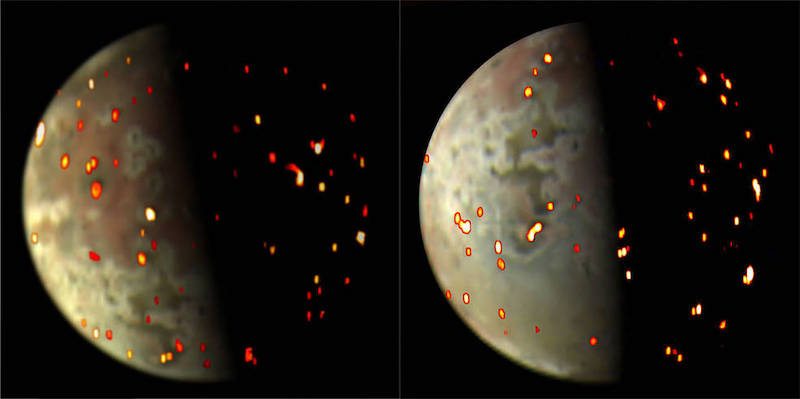
A potentially volcano-covered world
Volcanoes are common in our solar system. They are on some planets and on some of their moons. On May 17, 2023, a team of astronomers from around the world said it had discovered an Earth-sized exoplanet in a distant solar system. They said it might be covered in active, erupting volcanoes. The planet has been labeled as LP 791-18 d. It might be as volcanically active as Jupiter’s moon Io, which is the most volcanically active world in our solar system. But this new volcano-covered planet is located far beyond our solar system, some 90 light-years away. It might also have an atmosphere and water on its cooler night side.
The research team, led by graduate student Merrin Peterson at the Trottier Institute for Research on Exoplanets (iREx) at the University of Montreal, published its tantalizing peer-reviewed findings in Nature on May 17, 2023.
Co-author Björn Benneke at iREx said:
The discovery of this exoplanet is an extraordinary find. The similarity in the properties of LP 791-18 d and Earth as well as the prospect of detectable geological activity and volcanism on it make it a key object to better understand how terrestrial worlds form and evolve.
Meet exoplanet LP 791-18 d
LP 791-18 d orbits a red dwarf star, in the direction of our constellation Crater. The astronomers estimate it to be only slightly larger and more massive than Earth. Its density is also similar to Earth’s. The astronomers also calculated the equilibrium temperature of the planet to be 300-400 Kelvin (27-127 C or 80-260 F). The planet resides in the inner edge of the star’s habitable zone.
The researchers discovered the planet using data from NASA’s Transiting Exoplanet Survey Satellite (TESS) and the retired Spitzer Space Telescope, as well as multiple ground-based observatories.
Unlike Earth, however, it is tidally locked, meaning that it always keeps the same side facing its star. If there was no atmosphere, then one side of the planet would be perpetually hotter than the other. But there is a good probability that the planet does have an atmosphere, given all the volcanic activity. If so, the night side may be cool enough for water to condense on the surface. Benneke explained further:
LP 791-18 d is tidally locked, which means the same side constantly faces its star. The day side would probably be too hot for liquid water to exist on the surface. But the amount of volcanic activity we suspect occurs all over the planet could sustain an atmosphere, which may allow water to condense on the night side.
The researchers say the planet’s atmosphere, if present, is likely similar to that of Earth, Venus or Titan.
Neighboring bigger planet plays a role
So, how did LP 791-18 d become so volcanically active? The researchers say that you can thank another planet in the system for that. LP 791-18 c, discovered in 2019, is farther out from the star. It’s 2.5 times the size of Earth and more than seven times its mass. This makes it either a super-Earth or a mini-Neptune. As the planet orbits, it periodically comes very close to LP 791-18 d. At their closest, the two planets are only 0.9 million miles (1.5 million km) apart, 33 times closer than Mars and Earth ever get to each other. Since it is larger and more massive than planet d, planet c exerts a strong gravitational pull on planet d.
According to the new data, it’s enough to cause internal friction and heat in planet d. This could create on-going volcanic activity. This is also similar to Io, where the gravitational pull of Jupiter helps creates heat and sustain persistent volcanic eruptions. As Caroline Piaulet at iREx explained:
The significant friction generated by tidal heating in the planet is responsible for heating its interior to a considerable extent, ultimately enabling the existence of a subsurface magma ocean. In our solar system, we know that Jupiter’s moon Io is affected by Jupiter and its other moons in a similar way, and that world is the most volcanic we know.

Life on a volcano-covered world?
If LP 791-18 d is volcanically active and has an atmosphere, could it harbor life? While we have no way of knowing right now, it does seem possible. As co-author Jessie Christiansen at the NASA Exoplanet Science Institute at the California Institute of Technology (Caltech) said:
A big question in astrobiology, the field that broadly studies the origins of life on Earth and beyond, is if tectonic or volcanic activity is necessary for life. In addition to potentially providing an atmosphere, these processes could churn up materials that would otherwise sink down and get trapped in the crust, including those we think are important for life, like carbon.
Benneke added:
This system provides astronomers with a precious laboratory for testing various hypotheses related to the formation and evolution of terrestrial planets. The newly found planet d, an Earth-size world likely covered in volcanoes in a multiplanetary system, provides unprecedented opportunities to advance not only astronomy but many other fields of science, notably geology, planetary sciences, atmospheric sciences, and possibly astrobiology.
There is also a third known planet in this system. LP 791-18 b, also found in 2019, orbits closer to the star and is approximately 20% larger than Earth. LP 791-18 c is already a target for the Webb Space Telescope, and the astronomers think that LP 791-18 d will be an exceptional target as well. So do we!
Bottom line: Astronomers say they have discovered an Earth-sized exoplanet 90 light-years away that may be a volcano-covered world, possibly as active as Jupiter’s moon Io.
Source: A temperate Earth-sized planet with tidal heating transiting an M6 star
Via Trottier Institute for Research on Exoplanets/ University of Montreal











